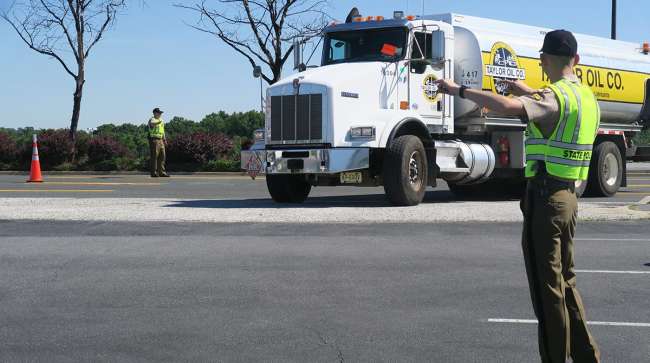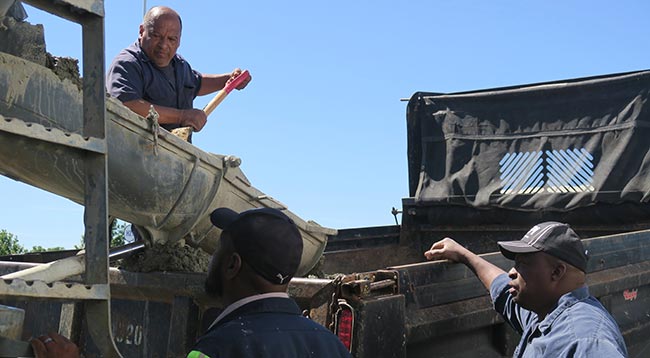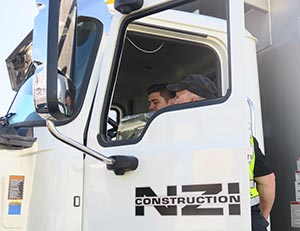Senior Reporter
Too Little Air, Too Much Cement: CVSA Roadcheck 2019 Uncovers Violations

[Stay on top of transportation news: Get TTNews in your inbox.]
LANDOVER, Md. — It wasn’t exactly a lucky day for James Dasch, a 30-year veteran truck driver for Lucky Dog Industries.
Dasch was one of several hundred drivers who got pulled off the road at the exit for FedEx Field on the first morning of the annual three-day stepped-up law enforcement Roadcheck event on June 4. His truck was taken out of service for a small cut in the insulation of a brake air line.
Dasch was one of several hundred drivers directed to a parking lot at the home of the NFL’s Washington Redskins on the first morning of the June 4-6 Commercial Vehicle Safety Alliance’s special event throughout the United States, Canada and Mexico.
Dasch wasn’t happy about the inspection outcome, but he was understanding. “Truckers have a job to do, and these inspectors have a job to do,” he said. “They help keep us safe.”
About 130 officers and inspectors with the Maryland State Police and representatives of eight other agencies were on hand to conduct inspections and help out.
This year’s Roadcheck emphasis was on steering and suspension systems, said Capt. Josh Barnes of the Maryland State Police.
During last year's International #Roadcheck, from all inspections conducted, inspectors identified 11,910 vehicles with out-of-service conditions and 2,666 drivers with out-of-service conditions. This year's Roadcheck starts today, June 4. https://t.co/z3Exvhh387 pic.twitter.com/oB4n2TkfKd — CVSA (@CVSA) June 4, 2019
Last year, about 700 trucks passed through the FedEx Field parking lot, but only 358 were inspected. Of those inspected, 102 were placed out of service, Barnes said.
Federal Motor Carrier Safety Administrator Ray Martinez, on hand for the Roadcheck kickoff, said the three-day event would help make U.S. highways safer.
During the enforcement effort, inspectors primarily were conducting North American Standard Level I Inspections, a 37-step procedure that includes an examination of driver operating requirements and vehicle mechanical fitness. However, inspectors said they may opt to conduct the Level II Walk-Around Driver/Vehicle Inspection, Level III Driver/Credential/Administrative Inspection or Level V Vehicle-Only Inspection, CVSA said.
The Level I vehicle inspections include checking critical items such as: brake systems; cargo securement; coupling devices; driveline/driveshaft; driver’s seat (missing); exhaust systems; frames; fuel systems; lighting devices (headlamps, tail lamps, etc.); steering mechanisms; suspensions; tires; van and open-top trailer bodies; wheels, rims and hubs; and windshield wipers.
There was an isolated area in the parking lot several hundred yards from the flow of traffic designated for trucks placed out of service for problems ranging from securement violations to bald tires.
One however, stood out: A driver and two helpers for Rockville Fuel and Feed, whose truck was overweight, were spending their morning dumping 6,000 pounds of fresh cement into a dump truck.

The helpers shovel fresh cement. (Eric Miller/Transport Topics)
“We have to get the weight of the truck down to 70,000 pounds,” said the driver, George, who declined to give his last name. “This will delay my deliveries by several hours.”
Driver Charles Smith, whose truck had a cracked frame, was waiting to be towed. “This is the first time this has ever happened to me,” said Smith, who drives for Lord Baltimore Towel Rental Service.
David Gibson, a driver for Sheldon’s Delivery Service, was waiting for helpers to replace two tires that were low on air and were nearly bald.
“It’s a bit of a headache,” Gibson said. “But the inspector said it was for my safety, that they were low on air and could blow out. You gotta respect that.”

Martinez sits as his vehicle is inspected. (Eric Miller/Transport Topics)
One dump truck driver, Jorge Martinez, who drives for NZI Construction, said he was happy to receive an inspection. “I saw the sign and I decided to pull in for an inspection,” Martinez said. “I knew the truck was going to be good. It’s pretty new.”
He passed.
International Roadcheck is a CVSA program with participation by FMCSA, Canadian Council of Motor Transport Administrators, Transport Canada and Secretaría de Comunicaciones y Transportes (SCT) (Ministry of Communications and Transportation) of Mexico.

